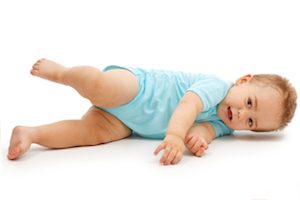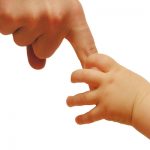
 Like other gross motor milestones, rolling over is full of fuel for your baby’s development. It’s his first experience moving his entire body, and continues to strengthen his muscles, balance, and coordination. It’s a big step in his sensory development as he builds an internal sense of his body and how he can move its parts to achieve a goal. Rolling helps him learn to interact with his environment as he is exposed to new textures, temperatures, sights, smells, tastes and sounds. Language learning widens as he begins to purposefully explore his surroundings and seek out interaction with you.
Like other gross motor milestones, rolling over is full of fuel for your baby’s development. It’s his first experience moving his entire body, and continues to strengthen his muscles, balance, and coordination. It’s a big step in his sensory development as he builds an internal sense of his body and how he can move its parts to achieve a goal. Rolling helps him learn to interact with his environment as he is exposed to new textures, temperatures, sights, smells, tastes and sounds. Language learning widens as he begins to purposefully explore his surroundings and seek out interaction with you.
Highlights:
|
When do Babies Roll Over?
Babies start to roll from front to back around 4 months. They usually master rolling from both front and back around 6 months. Like all milestones, this is based on averages. If you’re concerned about your baby’s development, you can always check in with your pediatrician.
Pediatric Physical Therapist Dr. Andrea Hayward, MSPT, DPT says that often, babies roll over for the first time by accident. They’ve spent many weeks on their tummies lifting and moving their heads, strengthening their muscles, and leaning from one side to another. One day they lean far enough to one side in the right position and boom!
After that, driven by vision and curiosity, your baby will roll to explore his environment.
Rolling Over and Movement
Rolling over is your baby’s first experience with full-body, independent, purposeful movement. It uses and strengthens all of his muscles. Especially important are the pelvis and trunk muscles, which he will soon use to pull himself up to sitting. Also important for sitting up are the arms, which he will use to push against the floor, prop himself up, and catch himself if he starts to fall over.
Rolling Over and Sensory-Motor Integration
Sensory-motor integration is what allows us to use our bodies without thinking about it (knowing how high to lift our leg to step out of the tub, for example) and being able to move in a balanced and coordinated way.
Pediatric Occupational Therapist Natasha Bravo, M.S., OTR/L explains that rolling helps develop two important senses involved in sensory-motor integration: Vestibular (a sense of our body in space) and proprioceptive (a sense of our body parts and how they work together). Rolling helps your baby understand where his body parts are in relation to the ground, to each other, and to objects around him. These “internal” senses help him navigate his environment and adapt to information he receives through his “external” senses (touch, sight, smell, taste and sound).
Our environment is full of external sensory information, which would be overwhelming if we hadn’t learned to understand and respond to it as babies. Movement milestones gradually introduce your baby to sensory information and what to do with it: He rolls from a soft blanket onto a wood floor, feels that it is hard and cold, and rolls back onto the blanket. Or he rolls into a spot of sunshine, notices the light has changed, and closes his eyes against the brightness. In these ways, he becomes accustomed to taking in, organizing, and using information from the environment.
Rolling Over and Language Development
Curiosity-driven play, within the context of meaningful interactions, is the main driver of language development for your baby, and will be for much of his childhood. Pediatric Speech-Language Pathologist Mandy Alvarez, M.S., CCC-SLP says that rolling over is an important milestone for play because you can begin to follow your baby’s lead as he explores a whole new world. He will seek out things that interest him and you can follow along, labeling and talking about them. He will love this interaction with you, and it will motivate him to continue exploring and connecting with you. These interactions also teach him about expressing himself (I want that toy), cause and effect (I shake this toy, you laugh), and non-verbal communication (you’re smiling, that means I should keep doing this).
The more your baby rolls around, the more he will learn, so try to keep him on the ground as much as possible! Remember to baby-proof rooms and keep an eye on him (or he may eat the dog food). If you’re outside, bonus! Rolling on grass offers a great sensory experience for babies. Check out our BabySparks app for over a dozen activities you can do with your baby to encourage this important milestone.








